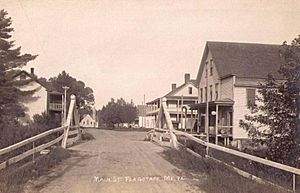List of ghost towns in Maine facts for kids
Have you ever heard of a 'ghost town'? It's a place where people used to live and work, but now it's mostly empty. Imagine houses, schools, and shops with no one around! Maine has several of these fascinating places. They became ghost towns for many reasons, like industries closing or new lakes being built. These towns offer a glimpse into the past, showing us how communities can change over time.
Contents
Ghost Towns of Maine
Maine's history is filled with stories of towns that once thrived but are now quiet. These "ghost towns" tell tales of changing industries, natural events, and people moving on. Let's explore some of these interesting places.
Appledore
Appledore is part of the Isles of Shoals, located off the coast of York County. This island was once a busy fishing community. It also became a popular summer resort in the 1800s. People would visit for its fresh air and beautiful views. Over time, the resort business slowed down. Many buildings were lost to fires or storms. Today, Appledore Island is mostly used for marine research. It is a quiet reminder of its lively past.
Askwith
Askwith is a former town in Piscataquis County. It is now known as Tarrantine. This area was likely a small settlement. It might have been built around a specific industry, like logging. When that industry faded, people moved away. The name change suggests a new purpose or a new way of life for the area. It shows how places can transform over many years.
Flagstaff

Flagstaff was a thriving town in Somerset County. It had homes, a school, and a church. However, its fate was sealed in the 1950s. The town was intentionally submerged to create Flagstaff Lake. This large lake was built to help control water flow for power generation. The residents of Flagstaff had to move. Their homes and buildings were either moved or left behind to be covered by water. Today, the old town site lies beneath the lake's surface. Sometimes, during very dry periods, parts of the old town can still be seen.
Freeman
Freeman is a former town in Franklin County. Like many small rural towns, Freeman likely saw its population decline over time. This often happens when farming or logging jobs disappear. Young people might move to bigger cities for more opportunities. The town slowly became less populated. Today, it stands as a quiet reminder of Maine's agricultural past.
Ligonia Village
Ligonia Village was a community within South Portland in Cumberland County. This village was likely a neighborhood or a small industrial area. As South Portland grew, Ligonia Village might have been absorbed into the larger city. Its unique identity as a separate village faded. This is a common story for small communities near growing urban areas. They become part of the bigger picture.
Perkins Township
Perkins Township is also known as Swan Island. It is located in Sagadahoc County. This island community once had residents and a small village. Over time, the population decreased. Today, Swan Island is mostly a wildlife management area. It is managed by the state of Maine. It protects animals and plants. Visitors can explore the island, but it is no longer a populated town.
Riceville
Riceville is another name for Township 39 in Hancock County. This area was likely a very small, remote settlement. It might have been a logging camp or a small farming community. When the resources ran out or the jobs moved elsewhere, people left. Remote towns often become ghost towns because they are harder to reach. They also depend on very specific industries.

